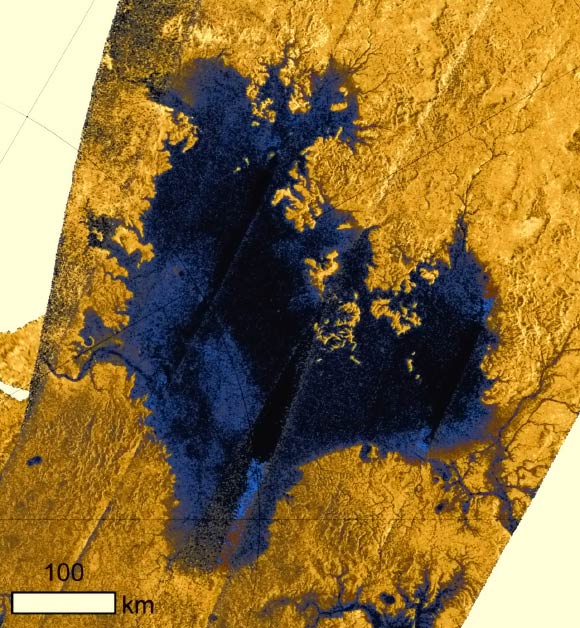The surface of Titan – the largest moon of Saturn – dissolves in a similar process that creates sinkholes on our planet, says a team of scientists led by Dr Thomas Cornet of the European Space Astronomy Center.

Close-up radar image of Ligeia Mare, the second largest known body of liquid hydrocarbons on Titan. Image credit: NASA / ESA / T. Cornet.
Titan has vast lakes of methane and ethane on its surface, but what makes the depressions they lie in?
Dr Cornet and his colleagues from the European Space Astronomy Center and CNRS in France have turned to Earth for the answer and discovered that Titan’s lakes are reminiscent of karstic landforms seen on our home planet.
These are terrestrial landscapes that result from erosion of soluble rocks such as limestone and gypsum in groundwater and rainfall percolating through rocks. Over time, this leads to features including sinkholes and caves under humid climates, and salt-pans under more arid climates.
The rate of erosion depends on factors such as the chemistry of the rocks, the rainfall rate and the surface temperature. While all of these aspects clearly differ between Titan and Earth, the underlying process may be surprisingly similar.
The scientists calculated how long it would take for patches of Titan’s surface to dissolve to create these features. They assumed that the surface is covered in solid organic material, and that the main dissolving agent is liquid hydrocarbons, and took into account present-day models of the moon’s climate.
They found that it would take 50 million years to create a 330 feet (100 m) deep depression at Titan’s relatively rainy high polar latitudes, consistent with the youthful age of the moon’s surface.
“We compared the erosion rates of organics in liquid hydrocarbons on Titan with those of carbonate and evaporite minerals in liquid water on Earth. We found that the dissolution process occurs on Titan some 30 times slower than on Earth due to the longer length of Titan’s year and the fact it only rains during Titan summer,” explained Dr Cornet, who is the lead author on the study published in the Journal of Geophysical Research – Planets.

This image of Titan, taken by Cassini spacecraft, reveals differences in the composition of surface materials around hydrocarbon lakes and seas on this largest moon of Saturn. Image credit: NASA / JPL-Caltech / University of Arizona / University of Idaho.
“Nevertheless, we believe that dissolution is a major cause of landscape evolution on Titan, and could be the origin of its lakes.”
The team also calculated how long it would take to form lake depressions at lower latitudes, where the rainfall is reduced.
The much longer timescale of 375 million years is consistent with the relative absence of depressions in these geographical locations.
“This is a great comparative study between our home planet and a dynamic world more than a billion kilometers away in the outer Solar System,” said co-author Dr Nicolas Altobelli of the European Space Astronomy Center.
_____
Thomas Cornet et al. Dissolution on Titan and on Earth: Toward the age of Titan’s karstic landscapes. Journal of Geophysical Research – Planets, published online June 04, 2015; doi: 10.1002/2014JE004738







